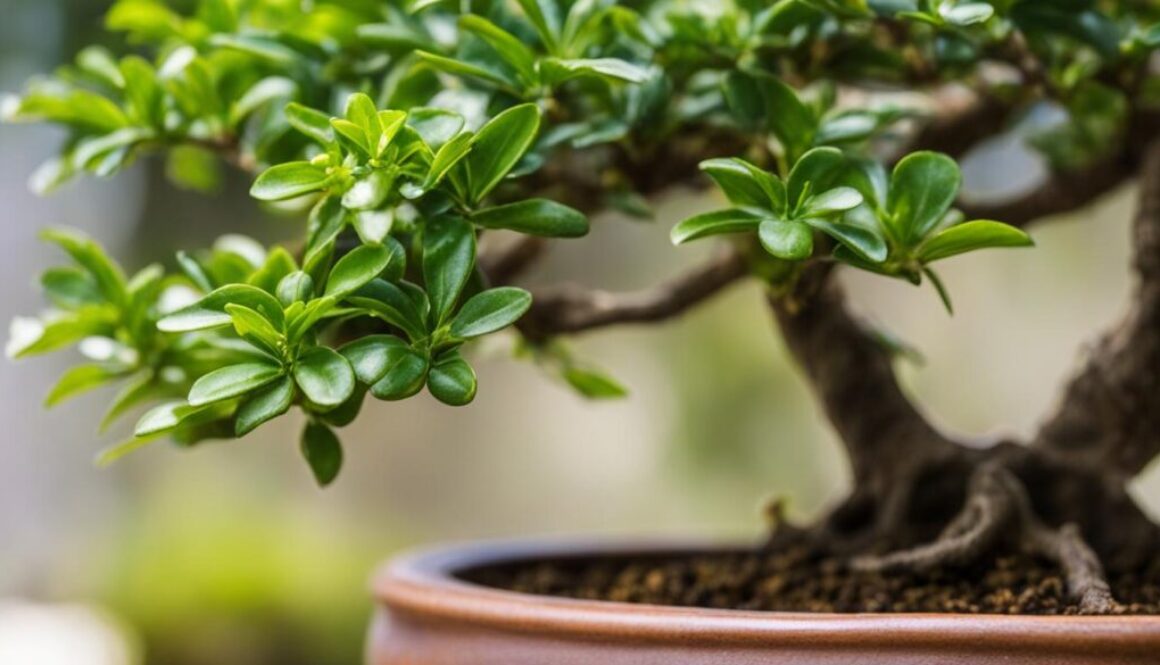Care Guide for Fukien Tea Bonsai Tree (Carmona retusa)
Welcome to our comprehensive care guide for the Fukien Tea Bonsai Tree, also known as Carmona retusa. Whether you’re a bonsai enthusiast or just starting your journey with indoor bonsai trees, this guide is packed with valuable information to help you create and maintain a thriving miniature tree in your own home. From bonsai care tips and pruning techniques to Fukien tea bonsai care and creating bonsai tree designs, we’ve got you covered. Let’s dive in and explore the world of the beautiful Fukien Tea Bonsai Tree.
Understanding the Fukien Tea Bonsai Tree Environment
Understanding the natural habitat and growth habits of the Fukien Tea Bonsai Tree is crucial for providing the optimal environment for its growth. The Fukien Tea is a subtropical evergreen shrub native to East and Southeast Asia, and it thrives in temperatures around 70°F (20°C). While it is traditionally an indoor bonsai, it can be kept outside in very warm climates. This section will delve into the specific environmental requirements of the Fukien Tea Bonsai Tree and how to create the ideal conditions for its growth.
Optimal Placement for Your Fukien Tea Bonsai Tree

Indoor Positioning for Year-Round Beauty
Fukien tea bonsai is one of the best indoor bonsais. Proper placement is crucial for the health and aesthetics of your Fukien Tea Bonsai Tree. When keeping your bonsai tree indoors, it is important to provide the optimal environment to ensure its year-round beauty. One of the key considerations is lighting requirements.
Fukien Tea Bonsai Trees thrive in bright, indirect light. Place your bonsai tree near a window with eastern or western exposure to provide the ideal lighting conditions. Avoid placing it in direct sunlight, as it can cause leaf burn.
Another important aspect of indoor positioning is adapting to seasonal changes. As the seasons transition, the lighting conditions and temperature inside your home may vary. Pay attention to the changing daylight hours and adjust the placement of your bonsai tree accordingly. During the winter months, when daylight is limited, you may need to supplement the lighting with artificial grow lights to ensure your bonsai tree receives adequate light for healthy growth.
Temperature requirements are also essential for the well-being of your Fukien Tea Bonsai Tree. It prefers temperatures around 70°F (20°C). Keep your bonsai tree away from drafty areas and extreme temperature fluctuations, such as heating vents or air conditioning units. Maintaining stable temperatures within the preferred range will help your bonsai tree thrive and maintain its beautiful appearance.
Adapting to Seasonal Changes
Adapting to seasonal changes is an important part of caring for your Fukien Tea Bonsai Tree. As the seasons progress, temperature variations and daylight hours fluctuate, requiring adjustments in your bonsai care routine.
During the warmer months, it is beneficial to place your bonsai tree outdoors in a shaded or partially shaded area, provided the temperature is within its preferred range. Outdoor positioning allows the tree to benefit from natural sunlight and fresh air, promoting healthy growth and vibrant foliage. However, monitor the weather conditions and bring your bonsai tree indoors if there is a risk of extreme temperatures or adverse weather.
As autumn approaches and temperatures begin to drop, it is time to prepare your bonsai tree for the transition to the indoors. Gradually acclimate your bonsai tree to its indoor environment by reducing its exposure to direct sunlight and adjusting the watering and fertilizing schedule. This gradual transition will help minimize stress and ensure a smooth adjustment for your bonsai tree.
During the winter months, provide your Fukien Tea Bonsai Tree with a cooler environment, ideally around 60-65°F (15-18°C). This cooler temperature mimics its natural dormant period and allows the tree to rest and conserve energy. Reduce watering frequency during this time, as the tree will require less moisture. However, continue to monitor the soil to ensure it remains slightly moist but not overly saturated.
Ensuring Adequate Lighting and Temperature
In addition to indoor positioning and adjusting to seasonal changes, it is crucial to ensure adequate lighting and temperature for your Fukien Tea Bonsai Tree throughout the year.
As mentioned earlier, Fukien Tea Bonsai Trees thrive in bright, indirect light. If you are keeping your bonsai tree indoors, place it near a window with eastern or western exposure to provide optimal lighting conditions. Consider using curtains or blinds to filter intense sunlight and prevent leaf burn. If natural light is limited, supplement with artificial grow lights to ensure your bonsai tree receives the necessary light for healthy growth.
Temperature requirements play a significant role in the overall health and vitality of your bonsai tree. Ideally, maintain temperatures around 70°F (20°C) for consistent growth and development. Avoid exposing your bonsai tree to extreme temperature fluctuations, as they can cause stress and impact its overall well-being. Consider using a thermometer to monitor the temperature in the vicinity of your tree and make adjustments as needed to maintain the optimal temperature range.
By providing the optimal lighting conditions and maintaining stable temperatures, you will create a favorable environment for your Fukien Tea Bonsai Tree to thrive and showcase its natural beauty.
Watering Your Fukien Tea Bonsai Tree
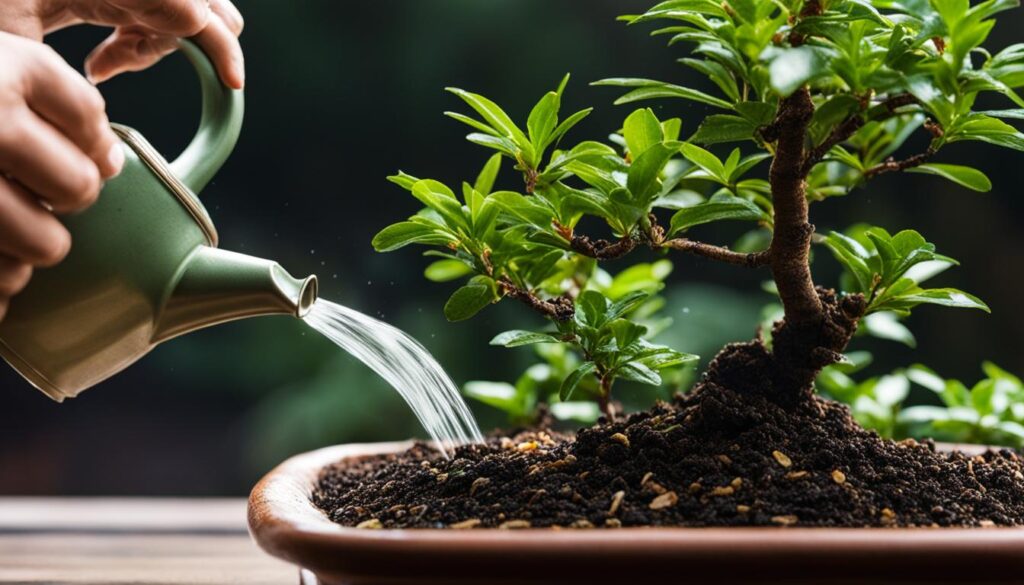
Proper watering is crucial for maintaining the health and vitality of your Fukien Tea Bonsai Tree. Understanding watering techniques, timing, and the water requirements of your bonsai tree is essential. Here, you will find detailed information on how to water your bonsai tree effectively, ensuring its optimal growth and preventing water-related issues.
When it comes to watering your Fukien Tea Bonsai Tree, it’s important to strike the right balance between underwatering and overwatering. Overwatering can lead to root rot and other detrimental conditions, while underwatering can cause stress and wilting.
To determine when to water your bonsai tree, observe the moisture levels of the soil. Your Fukien Tea Bonsai Tree prefers slightly moist soil, but not overly saturated. Stick your finger about an inch into the soil; if it feels dry, it’s time to water your bonsai tree.
The frequency of watering depends on several factors, such as the size of your bonsai tree, the pot size, and the environmental conditions. As a general rule, it is recommended to water your Fukien Tea Bonsai Tree when the top layer of soil feels dry to the touch.
Here are some additional watering techniques to keep in mind:
- Water your bonsai slowly and evenly, ensuring that moisture reaches all parts of the root system.
- Consider using a watering can with a fine nozzle or a watering wand to distribute water gently.
- Avoid watering your bonsai tree with chlorinated or hard water. If possible, use filtered or distilled water.
- Pay attention to the weather conditions and adjust your watering schedule accordingly. During hotter months, your bonsai tree may require more frequent watering.
Remember to monitor your Fukien Tea Bonsai Tree closely and observe any signs that may indicate overwatering or underwatering. Overwatering signs include yellowing leaves, mold or fungus growth, and a foul odor. Underwatering signs include wilted or drooping leaves and dry soil.
By following these watering techniques and understanding the water requirements of your Fukien Tea Bonsai Tree, you can ensure its optimal health and beauty.
Fertilizing the Fukien Tea Bonsai Tree
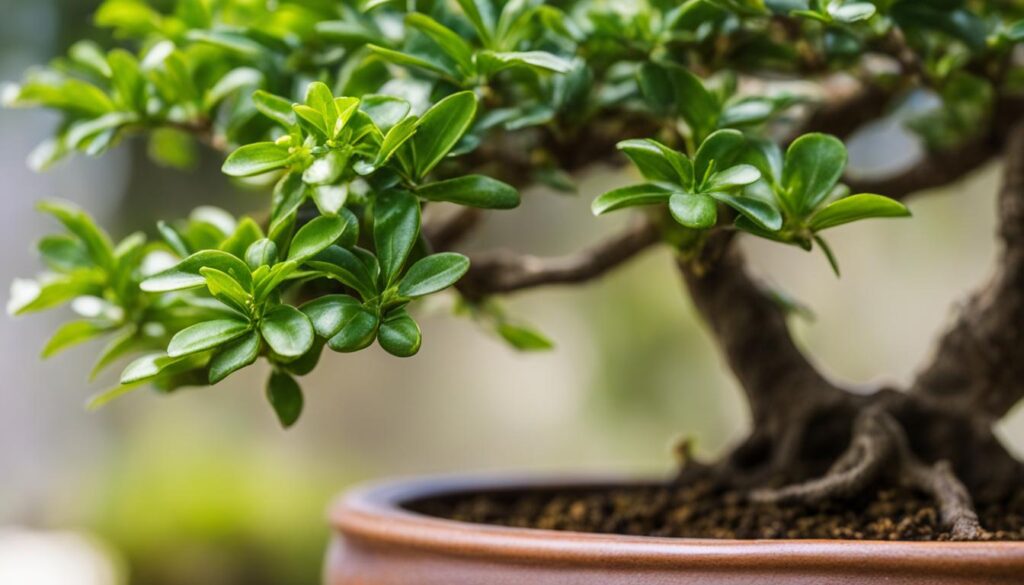
Fertilizing is an essential aspect of bonsai care to ensure the proper growth and development of your Fukien Tea Bonsai Tree. By providing the necessary nutrients, you can promote healthy growth, vibrant foliage, and overall tree vitality. In this section, we will explore the importance of choosing the right fertilizer and discuss the frequency of fertilization through the seasons.
Choosing the Right Fertilizer
When it comes to selecting a fertilizer for your Fukien Tea Bonsai Tree, it is crucial to consider its specific nutritional requirements. Look for a balanced fertilizer that contains a mix of nitrogen, phosphorous, and potassium (N-P-K) in appropriate ratios. Nitrogen promotes leaf and stem growth, phosphorus stimulates root development, and potassium enhances overall tree health.
Opt for a slow-release or organic fertilizer to provide a steady supply of nutrients over time. These types of fertilizers release nutrients gradually, preventing the risk of overfeeding or nutrient imbalances. Additionally, organic fertilizers enrich the soil with beneficial microorganisms, enhancing soil fertility and long-term tree health.
Fertilization Frequency Through the Seasons
The frequency of fertilization for your Fukien Tea Bonsai Tree will vary depending on the season and the tree’s growth stage. As a general guideline, fertilize your bonsai tree every two to four weeks during the growing season, which typically spans from spring to early autumn. This will provide the necessary nutrients for vigorous growth during this period of active development.
During the dormant winter months, reduce the frequency of fertilization to once every four to eight weeks. The tree’s metabolic activity slows down during this time, and excessive fertilization can lead to nutrient buildup or nutrient stress. Adjust the fertilization schedule according to your specific climate and the winter conditions in your region.
Always follow the instructions provided by the fertilizer manufacturer and avoid overfertilization, as it can cause burns to the tree’s roots and foliage. Regularly monitor your Fukien Tea Bonsai Tree’s growth and adjust the fertilization schedule accordingly, taking into account the tree’s individual needs and response to the fertilizer.
Pruning and Wiring Techniques for Fukien Tea Bonsai Tree
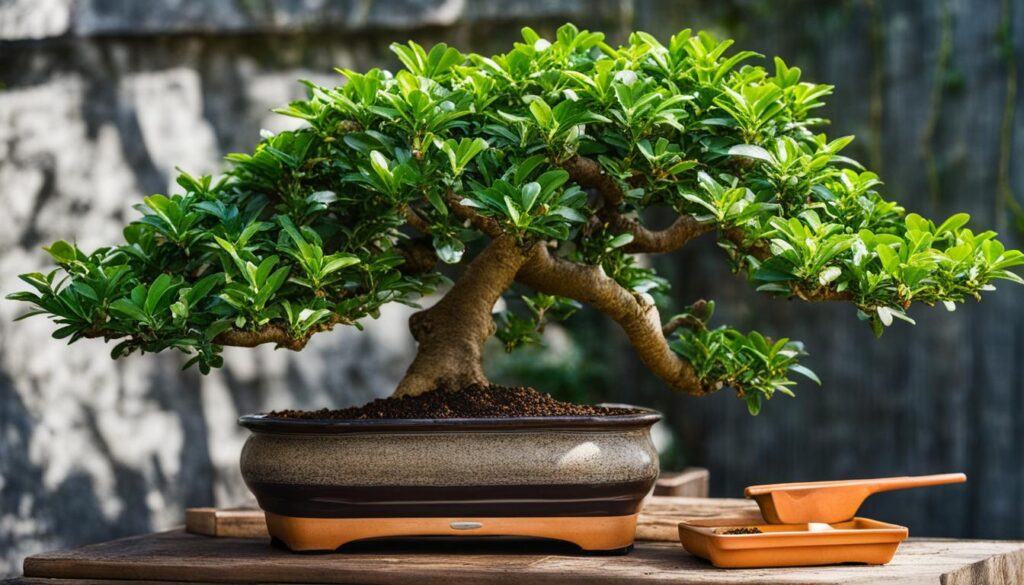
Pruning and wiring are essential techniques for maintaining the shape, aesthetics, and overall health of your Fukien Tea Bonsai Tree. Proper pruning helps promote branching, denser foliage, and aesthetic appeal, while wiring allows you to shape and train the branches to achieve your desired design and form.
When it comes to pruning your Fukien Tea Bonsai Tree, timing is crucial. The best time to prune is during the warmer months, ideally in late spring or early summer when the tree is actively growing. This allows the tree to recover quickly and minimize stress. Use sharp bonsai scissors or shears to make clean cuts, ensuring that you remove any dead, damaged, or overgrown branches. Additionally, selectively pruning the tips of healthy branches can encourage back-budding, which leads to denser foliage and a more compact tree.
Wiring is another technique that allows you to shape and train the branches of your bonsai tree. Before wiring, make sure the branches you intend to wire are flexible enough for shaping. You can use aluminum or copper bonsai wire, choosing the appropriate thickness based on the branch’s size and the desired degree of movement. Start by anchoring the wire at the base of the branch and wrap it around gently, applying moderate tension to guide the branch into the desired position. It’s important not to overtighten the wire to avoid damaging the branch’s cambium layer.
It’s essential to monitor the wired branches regularly to prevent the wire from cutting into the bark. Once the branches have set in their new position, typically after a few months, you can remove the wire carefully to avoid any potential damage. It’s recommended to remove the wire in a reverse fashion, unwinding it in the same direction it was initially applied.
Remember, pruning and wiring should always be done with caution and in moderation. Over-pruning or excessive wiring can weaken the tree and cause stress. It’s important to strike a balance and maintain the overall health and vigor of your Fukien Tea Bonsai Tree.
How to Properly Repot the Fukien Tea Bonsai Tree
Repotting is a critical aspect of bonsai care that ensures the proper growth and development of your Fukien Tea Bonsai Tree. Understanding when to repot, choosing the right soil mixture, and providing proper root care are essential for maintaining the health and vigor of your bonsai tree.
When to Repot Your Bonsai
Knowing when to repot your Fukien Tea Bonsai Tree is crucial for its overall well-being. Repotting should be done when the tree has outgrown its current pot or when the soil becomes compacted, hindering proper drainage and root growth. It is recommended to repot your bonsai tree every two to three years, preferably in early spring before the new growth starts.
Choosing Soil Mixture and Root Care During Repotting
When repotting your Fukien Tea Bonsai Tree, selecting the right soil mixture is vital. A well-draining soil mixture that retains moisture without becoming waterlogged is ideal. A suitable soil mixture for your bonsai tree can include a combination of organic matter, such as peat moss or pine bark, and inorganic components like perlite or lava rock.
Carefully remove your bonsai tree from its current pot, taking care not to damage the roots. Gently prune any overcrowded or tangled roots, and make sure to remove any dead or decaying roots. When repotting, place your Fukien Tea Bonsai Tree in the new pot with fresh soil, ensuring that the roots are spread out evenly. Firmly pack the soil around the roots to provide stability.
After repotting, water your bonsai tree thoroughly to settle the soil and provide hydration to the roots. Place your bonsai tree in a shaded area for a few weeks to allow it to recover from the repotting process.
Propagation Methods for the Fukien Tea Bonsai Tree
Propagation is an exciting way to expand your bonsai collection and create new Fukien Tea Bonsai Trees. This section will explore two popular propagation methods: using seeds and taking cuttings.
- Seeds: Collecting and growing bonsai seeds is a rewarding process. To collect seeds, wait for the Fukien Tea Bonsai Tree to produce fruit. Harvest the ripe, black seeds and remove any pulp. Fill a small pot with well-draining bonsai soil and plant the seeds at a depth of half an inch. Keep the soil moist and place the pot in a warm and well-lit area. With patience and care, the seeds will germinate, and you can nurture the seedlings into bonsai trees.
- Cuttings: Taking cuttings is another propagation method that allows you to create new bonsai trees from existing ones. Select healthy branches on your Fukien Tea Bonsai Tree and make a clean cut just below a leaf node. Dip the cut end in rooting hormone to stimulate root formation. Plant the cutting in a well-draining soil mixture, such as peat moss and perlite, and keep it moist. Provide a humid environment by covering the cutting with a plastic bag or placing it inside a propagating box. In a few weeks, the cutting will develop roots, and you can transplant it into a bonsai pot.
Note: Propagation requires patience and proper care. It may take several months or even years for the new plants to develop into mature Fukien Tea Bonsai Trees. However, the satisfaction of successfully propagating your own bonsai trees is well worth the wait.
Maintaining Health: Pests and Diseases of the Fukien Tea Bonsai Tree
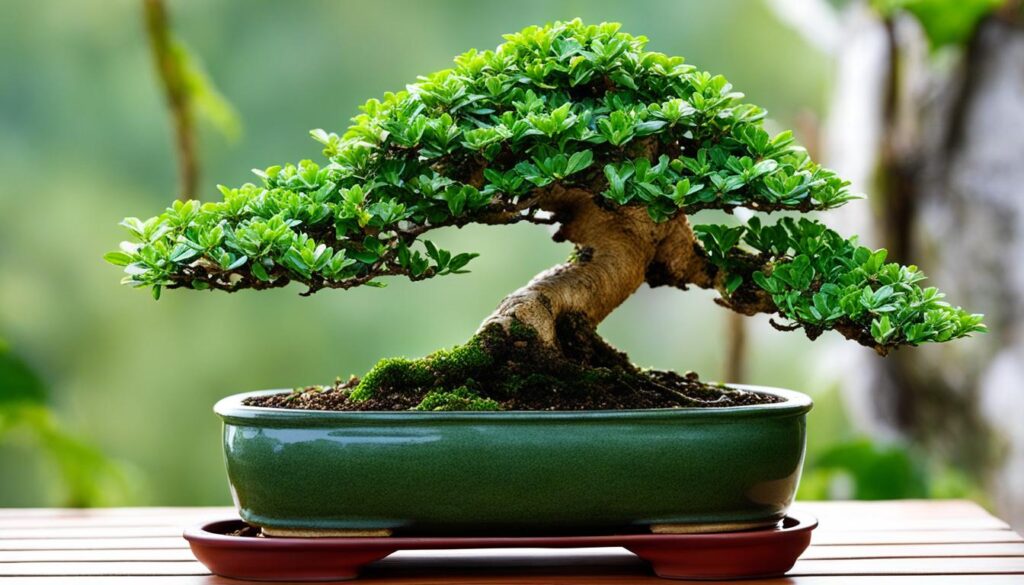
Like any other plant, the Fukien Tea Bonsai Tree is susceptible to pests and diseases. It’s important to be aware of the common pests and diseases that can affect the health and vitality of your bonsai tree. By understanding these potential threats, you can take proactive measures to ensure the long-term health and longevity of your Fukien Tea Bonsai Tree.
Common Pests:
- Aphids: These small, sap-sucking insects can cause stunted growth and yellowing leaves. To control aphids, you can use insecticidal soap or a gentle spray of water to dislodge them.
- Spider mites: These tiny pests can spin webs and cause leaf discoloration. Regularly misting your bonsai tree and keeping humidity levels high can help prevent spider mite infestations.
- Scale insects: These small, immobile insects attach themselves to the stems and leaves, feeding on the sap of the tree. Use a cotton swab dipped in rubbing alcohol to remove scales from the bonsai tree.
Common Diseases:
- Root rot: This fungal disease is often caused by overwatering or poor drainage. To prevent root rot, ensure that your bonsai tree is potted in well-draining soil and adjust your watering practices accordingly.
- Powdery mildew: This fungal infection appears as a white powdery coating on the leaves. Prune affected leaves and improve air circulation around the tree to control powdery mildew.
- Leaf spot: Leaf spot is characterized by dark, necrotic spots on the leaves. Remove and dispose of infected leaves and avoid overhead watering to prevent the spread of leaf spot.
Crafting the Aesthetics: Styling the Fukien Tea Bonsai Tree
Styling your Fukien Tea Bonsai Tree is a creative endeavor that allows you to showcase your unique artistic vision and create a visually striking bonsai design. By carefully selecting a bonsai style that complements the characteristics of the Carmona Retusa, you can enhance the natural beauty of your bonsai tree and create a captivating display.
Choosing a Bonsai Style that Complements the Carmona Retusa
When selecting a bonsai style for your Fukien Tea Bonsai Tree, it’s important to consider the tree’s characteristics, such as its foliage, trunk shape, and overall growth pattern. Popular bonsai styles that often complement the Carmona Retusa include the formal upright style, the informal upright style, and the cascading style. The formal upright style highlights the tree’s vertical growth, while the informal upright style emphasizes its elegant natural curves. The cascading style, on the other hand, showcases the delicate beauty of the Carmona Retusa’s cascading branches, creating a dramatic and eye-catching bonsai display. Choose a style that resonates with you and accentuates the unique features of your Fukien Tea Bonsai Tree.
Wiring and Reshaping Tips for Designing Your Bonsai
Wiring and reshaping are essential techniques in bonsai styling that allow you to shape and train the branches of your Fukien Tea Bonsai Tree to achieve the desired design. Before wiring, it’s important to ensure that your bonsai tree is healthy and strong. Carefully wrap bonsai wire around the branches, taking care not to damage the delicate bark. Guide the branches gently into the desired position, creating movement and balance in your bonsai design.
During the reshaping process, consider the overall aesthetics of your bonsai tree, striving for harmony between the trunk, branches, foliage, and pot. Prune excessive growth to maintain the desired shape and size, and regularly remove any dead or unhealthy branches. By combining wiring and reshaping techniques, you can create a visually captivating bonsai tree that showcases the unique beauty of the Fukien Tea Bonsai.
This page contains some affiliate links. Please check out our affiliate disclaimer for more information

Karen Phillips, Bonsai expert and blogger. Read more about me here

